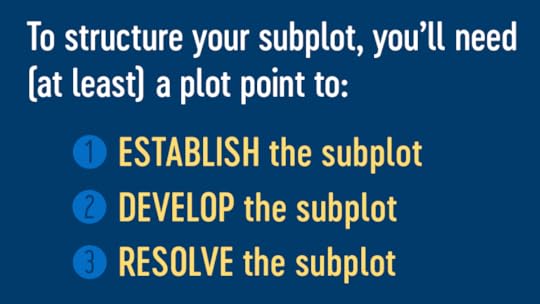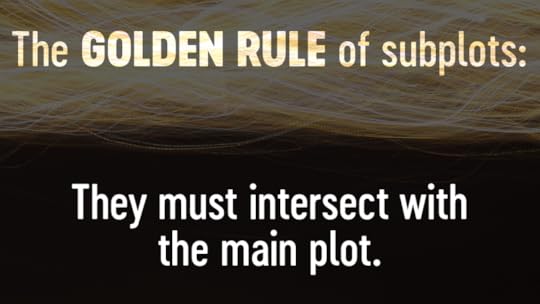Your “Easy As Pie” Guide to Subplots + Giveaway (Part 2 of 3)
by H.R. D’Costa, @scribesworld
Ah, subplots.
Once you get a handle on them, you’ll solve a huge problem.
You’ll be able to get your novel to the right length—without stretching your main plot too thin.
And while that’s a big benefit, it’s not the only one. Subplots can jazz up your story in multiple ways. We talked about that in Part 1 of this series.
Speaking of…
…here’s a quick overview of each part in this “easy as pie” guide to subplots.
In Part 1, we covered 5 uses for subplots.
In Part 2, we’ll cover how to structure your subplot—plus the golden rule to follow regarding subplots. (You’re reading Part 2 right now.)
In Part 3 (forthcoming), we’ll cover how to weave subplots into your story as well as conduct a subplot “safety check.”
Note: These subplot tips have been adapted from my writing guide Sparkling Story Drafts , which will help you write cleaner rough drafts, reduce your revision time, and get a crazy-good story onto the marketplace—faster. To learn how you could win a paperback copy, see the end of this post.
And now—fresh from the oven; mmmm!—today’s batch of tips…
How to Structure Your Subplot
Good news: the structure of your subplot doesn’t have to be extensive.
After all, it’s a subplot!
Structuring it should be fairly easy. First think about the story structure commonly found in main plots, and adapt it as you see fit. (This will usually entail some kind of “reduction.”)
If structuring the main plot is still a hazy area for you, consult this article on the essential plot points in a script outline. (Rest assured, these plot points work for novels, too!)
If you’re writing a cozy mystery, you might also find Elizabeth’s master outline to be helpful to work from. You can find it here.
While we’re on the topic of outlines…if you’re a “plotter” who outlines your story before you write, you’re probably totally onboard with sketching out the beats of your subplot in advance.
If you’re a “pantser,” who writes by the seat of your pants, without an outline, then sketching out your subplot in advance might make you feel uncomfortable. It might take away from your fun. In that case, use these tips retroactively, to evaluate the subplots in your rough draft.
Okay, with that plotter vs. pantser caveat out of the way, let’s get back to basic guidelines. At the very least, you’ll need three plot points for your subplot:
One to establish the subplot.
One to develop the subplot.
One to resolve the subplot.
To get a subplot worksheet that’ll help you keep track of your subplot plot points (plus more!), sign up here.
When you’re structuring your subplot (especially how you resolve it), there’s something you need to keep at the back of your mind…
The Golden Rule to Follow with Regard to Subplots
Remember how, in Part 1 of this series, I said that subplots provide a break from the main plot?
It’s no surprise, then, that subplots often exist parallel to the main plot, not really connecting to it.
As a result, if you’re not careful, your subplot can dangle from your story like a loose thread in a poorly made sweater.
Which means it’s going to feel extraneous.
It’s going to feel like filler.
To prevent this from happening, follow one golden rule:
Your subplot must intersect with the main plot.
Don’t just take it from me. Take it from literary agent Evan Marshall. As he explains in The Marshall Plan for Novel Writing:
The subplots and story lines that don’t work never really connect to the lead’s main story line. The reader patiently follows these threads, trusting they’ll converge at some point—but they never do…Don’t make this mistake; remember that readers assume from the very existence of a subordinate story line that it will fit somehow into the lead’s…story goal.
One word of caution: thematic intersections aren’t sufficient (even if you’re using your subplot to elucidate theme). Sorry theme aficionados :(
To truly be effective and possess the convergence that Marshall talks about, your subplot should affect the outcome of the main plot.
For example (as mentioned in Part 1 of this series), the subplot involving Kevin and Old Man Marley gives Home Alone its heart.
But this subplot does more than that.
That’s because, by rescuing Kevin from the burglars at the end of the film, Marley directly impacts the main plot.
Note: It’s usually not a good idea for your protagonist to be rescued at the end of your story. Why not? Getting rescued puts your protagonist in a passive position, which is generally undesirable. (See points #4 and #5 in this article by Michael Hauge.)
When this happens at the end of your story, it can undermine your entire climax. However, Home Alone is one of those exceptions that work.
That said, there are two structural spots when it’s usual for your protagonist to be in a passive position. One is at the inciting incident. In fact, passivity is one of its tell-tale signs.
The other is at the trough. This is my term for the setback (or series of setbacks) the protagonist encounters at the end of Act Two. (You may have heard the trough referred to as the “all is lost” or black moment.)
At the trough, your protagonist will often be stuck in a dicey situation. This is where subplots really come in handy.
Your subplot can contain the perfect resource to extricate your protagonist, so he’s free to participate in the climax.
This is a great way to create an intersection between a subplot and the main plot. Plus, because your subplot has been woven into your story from the outset (see Part 3 of this series for tips on how to do that), your protagonist’s extrication won’t seem contrived.
On the other hand, without the subplot, your protagonist’s extrication may come across as a deus ex machina—a plot device that annoys audiences to no end.
With a subplot in place, you avoid all this. (For the record, you can also avoid the dreaded deus ex machina through planting a well-timed setup.)
If creating intersections is a place where you get stuck, check out chapter 30 of Sparkling Story Drafts. I’ll walk you through examples, step by step. Don’t forget, we’re giving away copies of Sparkling Story Drafts. Details below…
Win a Paperback Copy of Sparkling Story Drafts
Three different opportunities to win—here’s opportunity #2!
For every post in this series, you have a chance to win a paperback copy of Sparkling Story Drafts ($24.99), which will help you write cleaner rough drafts, reduce your revision time, and get a crazy-good story onto the marketplace—faster.

For a chance to win today, answer this question in the comments: For you personally, what’s your biggest challenge regarding subplots?
Can’t think of anything offhand? No problem. Here are two alternate questions: (1) Has a subplot in a story ever annoyed you—and if so, why? or (2) What’s your favorite example of a subplot intersection?
Elizabeth will randomly select a winner from the comments by Wednesday, January 23.
Note: This giveaway is only open to residents of North America, South America, Europe, and the UK.
Good luck and happy writing!
Author Bio
A graduate of Brown University, H. R. D’Costa (a.k.a. HRD) almost became a lawyer. Twice. But then she realized that although she wanted to be a lawyer, she needed to be a writer. So she dedicated herself to studying films, screenplays, and novels in order to understand why some stories were gripping…while others were easy to walk away from.
Ultimately, she shared her discoveries in eight writing guides, including Sizzling Story Outlines: How to Outline Your Screenplay or Novel, Always Know “What Happens Next,” and Finish Your Rough Draft Without Freaking Out and Story Stakes: Your #1 Writing Skills Strategy to Produce a Page-Turner that Transforms Readers into Raving Fans of Your Screenplay or Novel, which one Amazon reviewer described as “a must-have in your top 10 books on writing.”
For practical, actionable writing tips designed to help you keep readers glued to your pages, visit her website scribemeetsworld.com, which is also home to the Ultimate Story Structure Worksheet (downloaded over 37,000 times by writers from around the world). Get it here.
Lattice-style pie by Dilyara Garifullina; Gold light by Maxime Valcarce
How to Structure Your Subplot by @ScribesWorld +giveaway :
Click To Tweet
The post Your “Easy As Pie” Guide to Subplots + Giveaway (Part 2 of 3) appeared first on Elizabeth Spann Craig.







